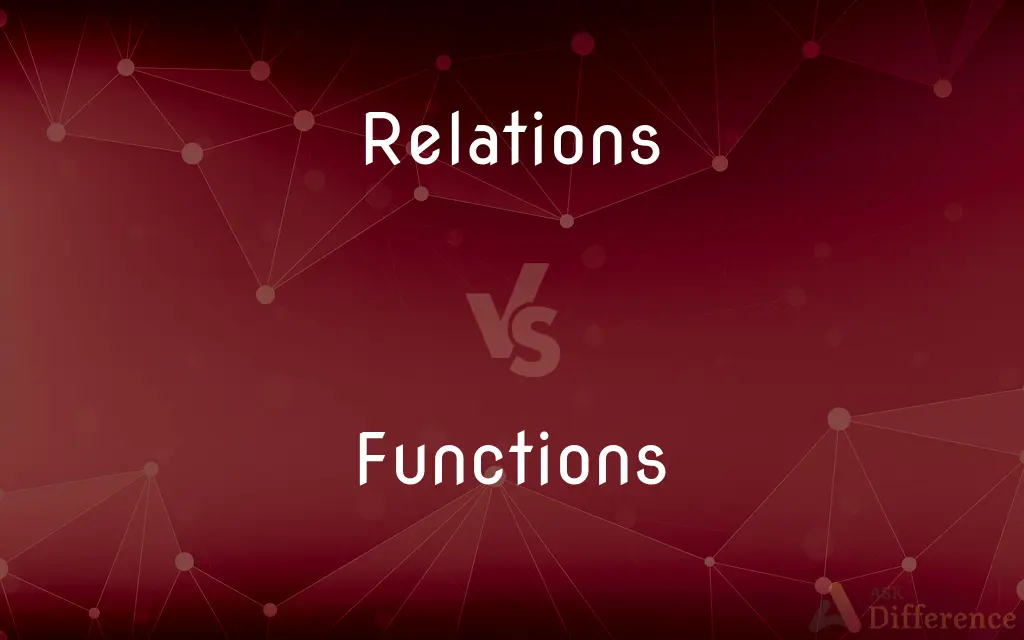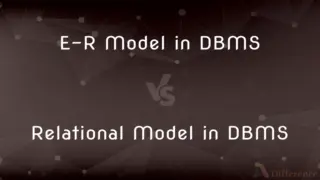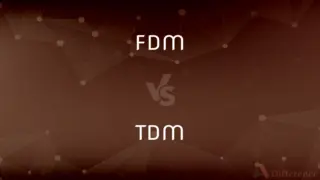Relations vs. Functions — What's the Difference?
Edited by Tayyaba Rehman — By Fiza Rafique — Published on January 12, 2024
Relations are any associations between sets of elements, while functions are specific types of relations where each input is associated with exactly one output.

Difference Between Relations and Functions
Table of Contents
ADVERTISEMENT
Key Differences
Relations in mathematics refer to any relationship between sets of elements. Functions, a subset of relations, are defined as relations where every input has a unique output.
While all functions are relations, not all relations qualify as functions. Functions require a single output for each input, whereas relations have no such restriction.
A relation can pair an element with multiple elements, but in a function, this one-to-many mapping is not allowed. Functions are, thus, more specific than general relations.
Representing relations can be done in various ways, including graphs or sets of ordered pairs. Functions, due to their specific nature, are often represented by graphs where each x-coordinate is paired with one y-coordinate.
In the context of functions, the concept of domain and range is critical, with each input (domain) associated with one output (range). In relations, the domain and range can have more complex associations.
ADVERTISEMENT
Comparison Chart
Definition
Any association between sets of elements
Specific relations with one output per input
Mapping
Can be one-to-many
Strictly one-to-one
Graph Representation
Can have multiple y-values for one x-value
Each x-value has a single y-value
Types
More general, various types
Subset of relations with specific properties
Domain and Range
Can have complex associations
Each domain element has one range element
Compare with Definitions
Relations
Any association between sets of elements.
In their research, they explored the relations between temperature and gas volume.
Functions
Specific relations with one output per input.
The function f(x) = x^2 showed a clear relationship between x and y.
Relations
Represented in various ways including graphs.
The graph showed the complex relations between the variables.
Functions
Each x-value has a single y-value in graphs.
In the function's graph, each x-coordinate corresponded to one y-coordinate.
Relations
Can have complex domain and range associations.
Their study on relations revealed diverse domain and range interactions.
Functions
Each domain element has one range element.
The function defined a clear output for every input value.
Relations
Can pair an element with multiple elements.
The relation between students and their preferred subjects was not exclusive.
Functions
Strictly one-to-one mapping.
For every input in the function, there was a unique output.
Relations
More general term in mathematics.
Understanding relations is fundamental before delving into specific types.
Functions
Subset of relations with specific properties.
Functions, a special kind of relations, have distinct mathematical properties.
Relations
A logical or natural association between two or more things; relevance of one to another; connection
The relation between smoking and heart disease.
Functions
A person's role or occupation
In my function as chief editor.
Relations
The connection of people by blood or marriage; kinship.
Functions
(Biology) The physiological activity of an organ or body part
The heart's function is to pump blood.
Relations
A person connected to another by blood or marriage; a relative.
Functions
(Computers) A procedure within an application.
Relations
The way in which one person or thing is connected with another
The relation of parent to child.
Functions
An official ceremony or a formal social occasion
Disliked attending receptions and other company functions.
Relations
The mutual dealings or connections of persons, groups, or nations in social, business, or diplomatic matters
International relations.
Functions
Something closely related to another thing and dependent on it for its existence, value, or significance
Growth is a function of nutrition.
Relations
Sexual intercourse.
Functions
A variable so related to another that for each value assumed by one there is a value determined for the other.
Relations
The act of telling or narrating.
Functions
A rule of correspondence between two sets such that there is exactly one element in the second set assigned to each element in the first set. Also called mapping.
Relations
A narrative; an account.
Functions
To have or perform a function; serve
Functioned as ambassador.
Relations
(Mathematics) A correspondence between two sets, consisting of a set of ordered pairs, the first element of each of which is from the first set, and the second element of each of which is from the second set. If A = {1,2} and B = {3,4}, then {(1,3), (1,4)} is a relation from A to B.
Functions
To deal with or overcome the challenges of everyday life
For weeks after his friend's funeral he simply could not function.
Relations
(Law) The principle by which an action done on a certain date is treated as having been done on an earlier date. Also called relation back.
Functions
Plural of function
Relations
Plural of relation
Relations
Mutual dealings or connections or communications among persons or groups
Common Curiosities
What’s an example of a relation that’s not a function?
A relation where an input is associated with multiple outputs.
How are functions represented graphically?
By graphs where each x-value is paired with one y-value.
Can functions have multiple y-values for one x-value?
No, functions must have a single output for each input.
What are relations in mathematics?
Associations between sets of elements.
What is the domain of a function?
The set of all possible input values.
What defines a function?
A relation where each input has exactly one output.
Can functions have complex domain and range associations?
Functions have simpler associations, with one domain element linked to one range element.
How do relations and functions differ in mapping?
Relations can have one-to-many mapping, while functions cannot.
Can a relation be a function?
Yes, if it has a unique output for every input.
Are all functions relations?
Yes, all functions are a type of relation.
What is the range of a function?
The set of all possible output values.
Is understanding relations important for learning functions?
Yes, it provides a foundational understanding.
Are there different types of functions?
Yes, there are various types like linear, quadratic, and exponential functions.
How do relations contribute to mathematical studies?
They provide a broader understanding of element associations.
Why are functions important in mathematics?
They are fundamental in understanding systematic relationships between variables.
Share Your Discovery

Previous Comparison
E-R Model in DBMS vs. Relational Model in DBMS
Next Comparison
FDM vs. TDMAuthor Spotlight
Written by
Fiza RafiqueFiza Rafique is a skilled content writer at AskDifference.com, where she meticulously refines and enhances written pieces. Drawing from her vast editorial expertise, Fiza ensures clarity, accuracy, and precision in every article. Passionate about language, she continually seeks to elevate the quality of content for readers worldwide.
Edited by
Tayyaba RehmanTayyaba Rehman is a distinguished writer, currently serving as a primary contributor to askdifference.com. As a researcher in semantics and etymology, Tayyaba's passion for the complexity of languages and their distinctions has found a perfect home on the platform. Tayyaba delves into the intricacies of language, distinguishing between commonly confused words and phrases, thereby providing clarity for readers worldwide.
















































